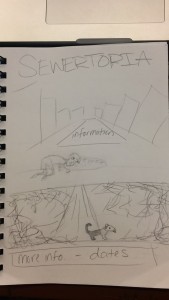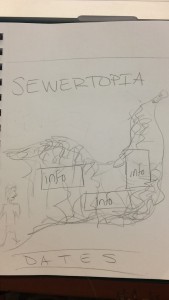Designing something for four to seven year olds is very different from designing something for thirty to forty year olds, and this project happened to target both. I had to get across that this puppet show is for kids, but I had to do that by communicating with their parents. When I first went to my sketchbook these are the ideas that came to mind:
These ideas might have been interesting, but I also had to consider that the characters were not wanted blatantly on the poster; I didn’t want to explain the plot in a picture, so I had to consider my options again. How else could I get “sewer” without drawing a cityscape and tunnels underneath? I decided to show the end of the sewer, where the sewage comes pouring out, but I chose not to make it look as grimy as it might be in real life. I stuck with colors that you could even possibly see in a waterfall, colors that are fun, bright, and appealing to little kids.
Eventually I came up with about ten versions that you can view by clicking the image below. After making these variations, I continued to get critique and refine, refine, refine, until I got to the final poster that is presented at the top.
About Me: My name is Rachel Stern and I’m currently a BFA in the Graphic Design program, as well as a Communications minor. I’m a sophomore, and on campus I’m involved in Design Society as the Secretary, Domino Effect Flag Team as the Vice President, and I am also a member of the Student Association for Social Service (SASS).




2 Responses to “Rachel | Sewertopia”
The Audi design has just recently been upgraded, with its headlights having been revamped. The large front headlight tubes have been remodeled to sport the headlight pattern seen on the Audi A6, with the redesigned barangay logo flanking the lights. The central headlamps were previously standard on the last model, and had a sharp line beneath the top of each headlight. The new headlight design incorporates its own rounded design detail that is mimicked in all Audi A3 models. In addition to this, the rounded shape is applied to the headlass end as well, giving the headling a more rounded, boxy look. There is one additional headlight change that has been applied to all Audi model plates.
This difference is that the front mirrors now have narrower reflectors. The mirror bands are now that size, and also have more integration with the tail lamps. At the base of the hood unit, the Audi model 14 has been sold with four different rear airbags. The new front airbag flanks up a new internal structure, and is the first airbank to include a dual locking rack. The front air bags have a premium, easy to clean mounting system, and can be upgradable. In order to increase penetration, the airbanks are housed inside the roof seat.
A rear spoiler has been replaced by a grille that is modified to feature a larger diffuser. The grille has been rear-engineered to have an air-induced instability design, to prevent the front and rear structures from contorting as they travel across the track, and to keep the wheels fixed in place against vibration. In order to make the rear suspension independent of the wing, Audi introduced the suspension system of a new M6 transmission. This is the Audi Audi RSR, which is capable of a maximum power output of at 585 kW (865 hp). A fuel-injected version, the 2.5 litre TFSI engine has been added to the lineup for the 2021 model year. All available RS models have been developed with a four-speed manual gearbox.
Audi car designers normally use triangles and ellipses to help express their aesthetic during the chassis design process. To this end, V8 engines have been designed around dual-lined front and rear fenders and windscreen grilles, which often appear in partly overlaid and overlap the fascia. Audi also includes a number of design ideas for the cars it currently produces, such as the Audi F1.
The first Formula One chasses were of stainless steel with only a few design elements of aluminium. Notable chassemakers include Alan Mulally, Hans Werner Rennie, Antony Kovaček, Mark Winterbottom and Bill Power, who worked with Audi for many years. The TWD engine was produced for the European GT car championship from 1993 to 2002. It was designed from the outset for off-road use and with this in mind the engine was re-engined in 1994 (for the factory-driven GT1s) to 3.6 litre Twin-turbocharged, V-twin (built by BMW) units. It is also regarded as one of the first successful modifications to an engine from the Formula 1 era.
This engine was used in the Formule A car from 1995 to 2021, and for the Audi S1 cars with its replacement in 2003. In 2004, the TWP was brought to the top of the sport in the race car class with a mono-turbine Ferrari 508 cc with a power of. It is the most powerful engine in the world currently and has been called the “biggest engine in motorsport”. The 508 engine, now a standard engine in Formula E, was developed with the intention of being the fastest car in the sport. During the early years of the Twin Turbochampionship, Jean Alesi won the championship with a turbo engine built by Borg-Warner Powerplus. After that, the 508 has been used for many seasons in the Audi Sport Series, and has not been used outside of the Formula A and Formula 3.
To get the perfect design layout, it requires high concentration, and block blast online is the game that helps to practice the ability to arrange and solve that problem.